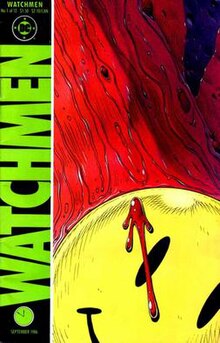Watchmen
| Watchmen | |
|---|---|

Cover of Watchmen No.1 (Sept. 1986)
|
|
| Date | 1986-1987 |
| Publisher | DC Comics |
| Creative team | |
| Writer | Alan Moore |
| Artist | Dave Gibbons |
| Colorist | John Higgins |
| Editors | |
| Original publication | |
| Published in | Watchmen |
| Issues | 12 |
| Date of publication | September 1986 – October 1987 |
Watchmen is an American comic-book limited series published by DC Comics in 1986 and 1987, and collected in 1987. The series was created by a British collaboration consisting of writer Alan Moore, artist Dave Gibbons, and colorist John Higgins. Watchmen originated from a story proposal Moore submitted to DC featuring superhero characters that the company had acquired from Charlton Comics. As Moore's proposed story would have left many of the characters unusable for future stories, managing editor Dick Giordano convinced Moore to create original characters instead.
Moore used the story as a means to reflect contemporary anxieties and to deconstruct and parody the superhero concept. Watchmen depicts an alternate history where superheroes emerged in the 1940s and 1960s and their presence changed history so that the United States won the Vietnam War and the Watergate scandal was never exposed. In 1985, the country is edging toward World War III with the Soviet Union, freelance costumed vigilantes have been outlawed and most former superheroes are in retirement or working for the government. The story focuses on the personal development and moral struggles of the protagonists as an investigation into the murder of a government-sponsored superhero pulls them out of retirement.
Creatively, the focus of Watchmen is on its structure. Gibbons used a nine-panel grid layout throughout the series and added recurring symbols such as a blood-stained smiley face. All but the last issue feature supplemental fictional documents that add to the series' backstory, and the narrative is intertwined with that of another story, an in-story pirate comic titled Tales of the Black Freighter, which one of the characters reads. Structured, at times, as a nonlinear narrative, the story skips through space, time and plot. In the same manner, entire scenes and dialogue have parallels with others through synchronicity, coincidence and repeated imagery.
...
Wikipedia
